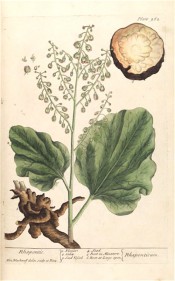Rheum rhaponticum L.
Perennial, rhizomatous herbaceous plant with large, heart-shaped leaves, to 45cm long, on long fleshy stems, and a dense, leafy inflorescence. to 1.8m, with white flowers. Culinary rhubarb of which there are many garden varieties. [RHSD, Hortus].
Horticultural & Botanical History
‘Rhapontic. Rhaponticum. The stalk grows about three foot high, the leaves are a deep grass green and the flowers whitish. It is planted in gardens and flowers in May. The root purges less than that of the true Rhubarb; but is accounted more restrigent and good in fluxes, spitting of blood, making of bloody water, and weakness of the stomach. It is one of the ingredients in the Theriaca Andromachi.’ [Blackwell pl.262/1739]. The plant described and illustrated in Blackwell may not be Rheum rhaponticum but another species. Although the text suggests this it is unclear from the illustration. Rhubarb has long had the medicinal uses described by Elizabeth Blackwell and Rheum rhaponticum was probably introduced to British medicinal herb gardens before 1573. Johnson’s Dictionary considers Rheum rhaponticum and Rheum undulatum to be different plants, the former introduced from Asia by 1573, the latter, ‘Wave-leaved Rhubarb’, from China in 1734. Improved forms for culinary use were not introduced until the 18th century and probably involved some hybridisation with other species [RHSD].
History at Camden Park
Rheum rhaponticum was marked with a ‘c’, indicating grown at Camden, in an 1836 Loddiges’ catalogue held at Camden Park [CPA]. Certainly grown in the gardens from at least this time, probably earlier.
Notes
Rheum rhaponticum S.G.Gmel. ex Ledeb. (c.1842) = Rheum tataricum L.f.
Rheum rhaponticum Delarbre (1800) = Rumex alpinus L.
In the 18th and early 19th centuries there was considerable controversy about the identity of the ‘true’ Rhubarb of commerce and medicine, the plant at this time being of considerable medical value but little used in cuisine. An article in Notes and Queries c.1856 attempts to clarify the situation.
Rhubarb – When introduced?
Miller (Gard. Dict., by Thos. Martyn, Univ. Camb., London, 1807), speaking of the seven different species of rhubarb, says :
1. Rheum Rhaponticum (Rhapontic rhubarb), native of Asia. It was cultivated in 1629 by Mr. John Parkinson (Hort. Kew.), who informs us that it was sent him from beyond sea by a worthy gentleman, Dr. Matth. Lister, one of the King’s physicians; and first grew with him, before it was ever seen or known elsewhere in England. (Parad. 484.)
2. Rheum undulatum (waved-leaved rhubarb), a native of China and Siberia, cultivated in 1759 by Mr. Miller. (Hort. Kew.)
3. Rheum palmatum (officinal rhubarb). Native of China and Tartary, cultivated before 1768 by Mr. Miller. (Hort. Kew.)
In the last folio edition of the Dictionary, which was published in that year, he says that the seeds had been then lately brought to England, from which many plants were raised ; but that the plant in the Chelsea Garden had not flowered, nor had he seen any plants in that state. In 1724 Professor Bradley (Husbandry and Gard., vol. iii. ch. ii. p. 64.) says, “I could wish that we could get some of the true rhubarb, if possible, for this has not yet grown in Europe, as I could ever find ; though once, I remember, the late ingenious Mr. Jacob Bobart thought he had got it. It was not until 1732 that botanists became acquainted with any species of Rheum, which seemed to afford the officinal rhubarb, when some plants received from Russia by Jussieu at Paris and Rand at Chelsea, were said to supply this important desideratum, and as such were adopted by Linnaeus In his first edition of the Species Plantarum, under the name of Rheum Rhubarbarum.” (Mr. Miller had the seeds from Boerhaave in 1734.)
This, however, was not very generally received as the true rhubarb ; and with a view to ascertain this matter more completely, Boerhaave procured from a Tartarian rhubarb merchant the seeds of the plants which produced the roots that he annually sold, and were admitted at St. Petersburgh to be the genuine rhubarb. These seeds were soon propagated, and were discovered by De Gorter to produce two distinct species, viz. the Rhubarbarum of Linnaeus, or as it has since been called, undulatum, and another, a specimen of which being presented to Linnaeus, he declared it to be a new one, and introduced it in his second edition of the Species Plantarum by the name of Rheum palmatum. Previous to this, De Gorter had repeatedly sent the seeds to Linnaeus, but the young plants which they produced constantly perished ; at length he obtained the fresh root, which succeeded very well at Upsal, and afterwards enabled the younger Linnaeus to describe this plant in 1767. But two years antecedent to this, Dr. Hope’s account of the Rheum palmatum, as it grew in the Botanic Garden near Edinburgh, had been read before the Royal Society in London. The seeds were, first introduced into Britain In 1762, by Dr. Mounsey, who sent them from Russia (Woodville); and these seeds were quickly dispersed over the island. Dr. Lettsom, in 1778, says that there is every reason to conclude that Rheum palmatum is the Turkey or Russia rhubarb. [Notes and Queries 3 (Second Series) p.15].
Published Feb 15, 2009 - 02:19 PM | Last updated Jul 29, 2010 - 05:24 PM
| Family | Polygonaceae |
|---|---|
| Category | |
| Region of origin | Siberia and Asia |
| Synonyms |
|
| Common Name | Common rhubarb, Rhapontic |
| Name in the Camden Park Record | Rheum rhaponticum |
| Confidence level | high |


